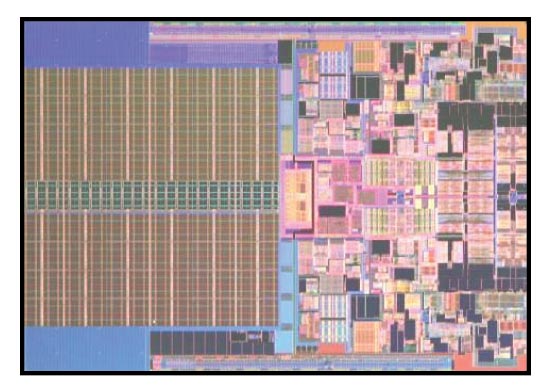Intel Demonstrates new 45nm Transistors and Conroe's Successor
by Anand Lal Shimpi on January 27, 2007 12:00 AM EST- Posted in
- CPUs
Conroe has a Son: Introducing Penryn
Intel announced the first working high-k + metal gate transistors back in 2003. By 2006 it had built an SRAM test vehicle (a wafer full of nothing but cache and some control/test logic) using the new transistors to work out most of the kinks in the manufacturing process.

Today, Intel is announcing that its first full CPU built using the new 45nm high-k + metal gate transistors is not only up and running, but it has also booted four OSes. The very first packaged Penryn silicon from the very first wafer booted Windows Vista, Mac OS X, Windows XP and Linux on the first try.
The picture below is of Intel's validation team after they successfully booted Penryn on the above OSes. The chips arrived in the lab at around 1AM and by 3AM they were up and running. If you're concerned, that's sparkling cider in those glasses and not champagne; alcohol is not allowed on Intel's campus, as it tends not to bring out the best in CPU designs, although it does make benchmark scores look infinitely higher.

It's a fairly big accomplishment to have first silicon working this well, but Intel has had a number of successful first spins in recent history. Generally by the time you're making your first CPUs, you've got the majority of the manufacturing defects worked out thanks to your SRAM test vehicle, so any problems with the first silicon are usually due to errors in the design or in the masks.
Intel also proudly sent us a shot of the 45nm Penryn die:

This version of Penryn is dual-core, and the first quad-core Penryn chips will simply be two of these on a single package, although later on we may see a single-die solution. At 410 million transistors, we expect a dual-core Penryn to have a 6MB shared L2 cache (up from 4MB in Conroe). The logic part of the Penryn core will be mostly evolutionary from Conroe, but do expect additional functionality and performance from more than just a larger cache.
If we assume that 288M transistors (6T SRAM) will be used by the 6MB cache, that leaves 122M transistors for L1 cache and the rest of the core. Applying the same calculation to Conroe gives us 99M transistors left over, meaning that there are roughly 23% more core-logic, control and L1 transistors being used in Penryn than in Conroe.

What that additional functionality will be is up in the air at this point, but you can expect SSE4 support to occupy a chunk of those transistors. At 45nm Intel should also be able to ramp up clock speed, so expect to see Penryn debut at over 3GHz easily. Given how overclockable Conroe turned out to be, we wouldn't be too surprised to see Penryn scale very well.
And the last bit of Penryn information Intel is letting out today is that it demonstrated Penryn up and running actual applications at a press briefing in Santa Clara on January 25th. There were five Penryn systems configured and clocked as follows:
1) 45nm dual core mobile processor in a notebook with Microsoft Vista running Microsoft Office 2003 applications.
2) 45nm dual-core desktop processor running high definition video content (1080P) under Microsoft Vista. 2.13 GHz
3) 45nm quad-core desktop processor running Ubisoft Rainbow Six Las Vegas game under Microsoft Vista. 1.86 GHz
4) Two 45nm dual-core processors running Glaze Workstation application under Microsoft Windows 2000 Advanced Server. 2.13 GHz
5) Two 45nm quad-core processors encoding a video in Adobe Premier under Microsoft Vista. 2.13 GHz
All of the systems were air-cooled using normal heatsink/fan units. Unfortunately Intel wouldn't share any benchmarks or more details of the systems other than what software they were running.
At this stage in the game it's normal to see clock speeds much lower than final shipping silicon, but this is the first time that Intel has been so forthcoming with clock speed data this far before launch. What we're seeing is a far more proud and confident Intel, and honestly it has every reason to be given the recent successes of Core 2 and promise of Penryn.










59 Comments
View All Comments
mostlyprudent - Saturday, January 27, 2007 - link
Do we have any info as to chipset/socket compatability for Penryn?MarkM - Saturday, January 27, 2007 - link
Whoa Nelly!!! They JUST achieved a first validation sample of the material, what, SIX HOURS AGO? Lord knows when they'll even have chipset details figured out, and a shipping CPU is still a year off.This is a moment to step back and marvel at the continued long term achievement of the semiprocessor industry, not obsess how your going to run Vista!
mino - Saturday, January 27, 2007 - link
Well, AMD stated that K8L will be drop-in compatible with SocketF/AM2 insrastructure in May 2006(if not sooner).That seems pretty much a yer ago from expected shipment date of mid-2007.
This was presented not only to public but also to its corporate customers! ...
To answer the original question:
Do not expect penryn to work with anything older than 965 series of chipsets on boards introduced by 2H07 or later.
mino - Saturday, January 27, 2007 - link
Meaning, ofcourse, that one should not expect penryn to be drop-in compatible with any current boards.Andrwken - Monday, January 29, 2007 - link
Actually, considering they are using unmodified hardware to run the chips. I would be rather surprised if they did not work on any core 2 capable motherboard. Correct me if I'm wrong, but a well researched motherboard purchase could get you a mobo that can run any 775 socket Prescook, Core 2 (dual or quad), and possibly Penryn? That's a pretty good lifecycle for a socket. How many has amd had in the last 2 years?JarredWalton - Monday, January 29, 2007 - link
I believe Penryn is scheduled for launch around the same time as Bearlake, and in the past we have seen a lot of official Intel platforms require a new chipset - whether or not the requirement is strictly necessary is obviously a different story. I believe Core 2 Duo is supposed to "require" P/G/Q965 or 975X, or one of a few select 945/946 chipset versions. Obviously, with 865 and 915 boards out there supporting the new CPUs, Intel's requirement was not strictly necessary, but most boards for C2D still use 965 or 975. What will happen with Penryn? I have no doubt we'll see some 965/975 boards that support it, but I'll be pleasantly surprised if the official requirement doesn't include Bearlake.Viditor - Tuesday, January 30, 2007 - link
I believe that Bearlake is out 3-6 months before Penryn (Q2-3 for Bearlake), but your point is taken...
mostlyprudent - Saturday, January 27, 2007 - link
Sorry for the pragmatic obsessiveness...cannot be helped!MarkM - Saturday, January 27, 2007 - link
No problem, I hope I didn't come off sounding more negative than I meant to be! Anyway I just happened to stumble on a partial answer to your question:http://www.dailytech.com/article.aspx?newsid=5869">linkflyck - Saturday, January 27, 2007 - link
IBM and AMD (who work together) already stated that they have a simular technology, http://www.eetimes.com/news/semi/showArticle.jhtml...">linkSo don't say doomed yet -_-